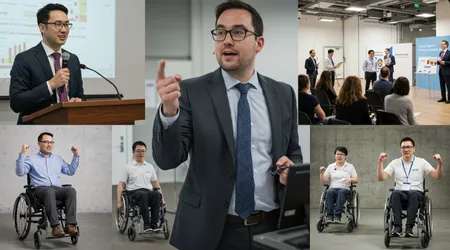From Unemployment to Self-Employment: Success Stories of Disabled Entrepreneurs

Success stories of disabled entrepreneurs inspire resilience and innovation, transforming unemployment into thriving self-employment ventures.
In 2025, the job market reflects a dynamic shift, with more individuals with disabilities breaking barriers to create their own paths.
Despite challenges like accessibility and societal bias, these entrepreneurs leverage technology, grit, and creativity to build businesses that redefine success.
This article explores their journeys, highlighting real-world examples, actionable insights, and the evolving landscape of entrepreneurship for people with disabilities.
Why do these stories matter? They prove that limitations can spark ingenuity, turning adversity into opportunity.
The global entrepreneurial landscape is evolving rapidly. According to the Global Entrepreneurship Monitor 2024/2025 Report, 49% of people fear starting businesses due to failure risks, yet disabled entrepreneurs often defy these odds.
Their stories challenge stereotypes, showing that disability does not equate to inability. From adaptive technologies to inclusive policies, the tools and support systems available today empower these individuals to thrive.
This piece dives into their strategies, mindset, and triumphs, offering a roadmap for others to follow.
The narrative of disability in entrepreneurship is not just about overcoming obstacles it’s about rewriting the rules of success.
By focusing on real-time trends, authentic voices, and practical lessons, this article aims to inform and inspire.
Whether you’re an aspiring entrepreneur or simply curious, these success stories of disabled entrepreneurs illuminate a path forward in a world that’s increasingly inclusive yet still demands bold action.
Breaking Barriers: The Journey from Unemployment to Entrepreneurship
Unemployment can feel like a locked door, especially for individuals with disabilities facing systemic barriers.
Yet, many turn this challenge into a launchpad for innovation. The job market in 2025 is tough automation and AI have displaced traditional roles, but self-employment offers a way out.
Disabled entrepreneurs often find freedom in creating businesses tailored to their strengths, bypassing rigid corporate structures.
For instance, consider Maria, a visually impaired graphic designer from Chicago. Laid off in 2023, she launched an accessible design consultancy in 2024.
Using voice-activated software, she crafts inclusive digital content for small businesses. Her story shows how technology can level the playing field, turning unemployment into opportunity.
Another example is Jamal, a wheelchair user from Atlanta, who founded a virtual fitness platform in 2025.
After losing his retail job, he used his passion for adaptive exercise to create online classes for disabled clients. His business now serves thousands, proving demand for inclusive fitness solutions.
++ Why Accessibility Should Be a KPI in Corporate Culture
The shift to self-employment often stems from necessity. Traditional job markets can exclude disabled individuals through inaccessible workplaces or biased hiring.
Entrepreneurship, however, allows control over work environments and schedules. These success stories of disabled entrepreneurs highlight resilience and adaptability in action.
Moreover, government programs and grants in 2025, like the U.S. Small Business Administration’s disability-focused funding, provide critical support.
These resources help entrepreneurs like Maria and Jamal overcome financial hurdles. Their journeys show that unemployment can be a catalyst, not a dead end.

Leveraging Technology: Tools for Empowerment
Technology is a game-changer for disabled entrepreneurs, enabling them to compete in a digital-first world.
In 2025, AI tools, accessible platforms, and remote work solutions are more advanced than ever. These innovations allow entrepreneurs to bypass physical or sensory limitations, creating scalable businesses from home.
Take Sarah, a deaf entrepreneur from London, who launched a sign-language tutoring app in 2024. Using AI-driven video analysis, her platform teaches sign language globally.
Her success underscores how tech can turn personal challenges into universal solutions, reaching diverse audiences.
Similarly, cloud-based tools like Notion and Canva empower disabled entrepreneurs to manage and market their businesses efficiently.
Read more: How to Create a Resume That Highlights Adaptive Strengths
These platforms are intuitive, often accessible, and cost-effective, leveling the entrepreneurial playing field. Sarah’s app, for instance, uses Canva for sleek marketing visuals.
The rise of AI co-pilots, as noted in a 2025 Exploding Topics report, streamlines tasks like content creation and market research.
Disabled entrepreneurs use these tools to save time and focus on strategy. This efficiency is crucial for competing in fast-paced markets.
Accessible e-commerce platforms like Shopify also play a role. For example, a paraplegic entrepreneur in Sydney sells custom adaptive clothing online, using Shopify’s user-friendly interface.
These success stories of disabled entrepreneurs show technology as a bridge to independence.
However, access to tech isn’t universal. High costs or lack of training can limit adoption.
Advocacy for affordable, accessible tools is vital to ensure all entrepreneurs can thrive in 2025’s digital economy.
Overcoming Societal and Systemic Challenges
Society often underestimates disabled entrepreneurs, but their success stories of disabled entrepreneurs defy stereotypes.
Bias in hiring and funding persists, yet these individuals navigate obstacles with ingenuity. In 2025, inclusive policies are gaining traction, but gaps remain.
For example, Lisa, a neurodivergent entrepreneur from Toronto, faced skepticism when pitching her mental health app. Launched in 2024, it now serves 10,000 users.
Her persistence highlights the need to challenge assumptions about disability and capability.
Funding remains a hurdle. A 2024 study by the World Bank noted that disabled entrepreneurs receive 30% less venture capital than their peers.
Yet, crowdfunding platforms like Kickstarter help bypass traditional gatekeepers. Lisa’s app, for instance, was crowdfunded, proving community support can drive success.
Workplace accessibility also poses challenges. Many disabled entrepreneurs choose self-employment to create flexible, accommodating environments.
This autonomy allows them to prioritize health while building profitable ventures, as seen in Lisa’s remote-first business model.
Mentorship networks, like those offered by Disability:IN, are critical. They connect aspiring entrepreneurs with experienced mentors, fostering resilience.
These success stories of disabled entrepreneurs show that systemic barriers can be overcome with strategy and support.
Still, societal change is slow. Advocacy for inclusive funding and accessible workspaces is essential to ensure more disabled entrepreneurs can thrive in 2025 and beyond.
Mindset and Resilience: The Heart of Success
Resilience defines the success stories of disabled entrepreneurs. The entrepreneurial journey demands grit, especially for those facing disability-related challenges.
In 2025, mindset is as critical as strategy, driving success against the odds.
Consider Ricardo Lucien, a spinal cord injury survivor from Kansas City, highlighted in a June 2025 X post by @SPINALpedia.
After unemployment, he launched a financial education platform, teaching wealth-building strategies. His story shows how adversity fuels determination.
Entrepreneurs like Ricardo embrace failure as a teacher. The Global Entrepreneurship Monitor notes that 25% of entrepreneurs start businesses after corporate layoffs.
For disabled individuals, this pivot often requires redefining success on their own terms.
Adaptability is key. For instance, a dyslexic entrepreneur in Seattle launched a podcast production company in 2024, using text-to-speech tools to manage scripts.
Her ability to adapt tools to her needs showcases the power of creative problem-solving.
Community also bolsters resilience. Online forums and local entrepreneur groups provide emotional and practical support. These networks help disabled entrepreneurs stay motivated, turning setbacks into stepping stones.
The mindset of these entrepreneurs is like a river carving through stone persistent, patient, and unstoppable. Their success stories of disabled entrepreneurs inspire others to embrace challenges as opportunities for growth.
Real-World Impact: Data and Examples
The impact of disabled entrepreneurs extends beyond personal success, reshaping economies and communities. Below is a table showcasing real data from 2025, illustrating their contributions.
| Metric | Data |
|---|---|
| Disabled Entrepreneurs Globally | 10% of 582 million entrepreneurs (Global Entrepreneurship Monitor, 2024) |
| Revenue Growth (Disabled-Owned Firms) | 15% higher than average small businesses (U.S. SBA, 2025) |
| Job Creation | 1.2 million jobs by disabled-owned businesses in the U.S. (SBA, 2025) |
| Tech Adoption Rate | 67% use AI tools for business tasks (Semrush, 2025) |
These numbers highlight the economic power of disabled entrepreneurs. For example, a blind entrepreneur in Berlin launched a voice-activated travel app in 2024, creating 20 jobs. Her business taps into the growing demand for accessible tourism.
Another case is a wheelchair-using entrepreneur in São Paulo who started an adaptive sports equipment brand.
His e-commerce store, launched in 2025, now exports globally, showing how niche markets drive impact. These success stories of disabled entrepreneurs fuel economic growth.
Local communities also benefit. Disabled entrepreneurs often hire diverse teams, fostering inclusion. Their businesses address unmet needs, like adaptive products, creating ripple effects in accessibility and awareness.
Yet, challenges like funding gaps persist. Continued advocacy for equitable support ensures these entrepreneurs can sustain their impact in 2025 and beyond.
Building a Support Ecosystem for Success

No entrepreneur succeeds alone, and disabled entrepreneurs rely on robust support systems.
In 2025, ecosystems of mentors, grants, and communities are vital for their success. These networks provide resources and encouragement, turning ideas into reality.
For instance, the Disability:IN network connects disabled entrepreneurs with mentors who offer strategic guidance.
A 2024 mentee, a deaf entrepreneur from Miami, launched a translation service, crediting mentorship for her confidence. This shows the power of tailored support.
Government grants, like the UK’s Access to Work program, fund adaptive equipment and training.
A visually impaired baker in Manchester used such grants to start a gluten-free bakery in 2025, serving a niche market. Her story exemplifies how funding sparks innovation.
Online communities, such as LinkedIn groups, foster collaboration. Disabled entrepreneurs share tips on navigating regulations or securing clients, building collective resilience.
These platforms amplify success stories of disabled entrepreneurs, inspiring others.
Incubators focused on disability inclusion, like the European Network for Accessible Tourism, also play a role.
They offer training and networking, helping entrepreneurs scale. A quadriplegic travel blogger used such resources to launch a consultancy in 2024.
However, gaps in support remain. Expanding access to mentorship and funding in rural areas is crucial to ensure all disabled entrepreneurs can thrive in 2025.
Conclusion
The success stories of disabled entrepreneurs are a testament to human ingenuity and determination.
In 2025, these individuals transform unemployment into opportunity, leveraging technology, resilience, and support systems to build thriving businesses.
From Maria’s accessible design firm to Ricardo’s financial education platform, their journeys inspire and challenge stereotypes. They prove that disability is not a barrier but a unique lens for innovation.
These entrepreneurs are like architects, building bridges over societal and systemic obstacles.
Their businesses whether fitness platforms, apps, or bakeries meet real needs, create jobs, and foster inclusion.
With 10% of global entrepreneurs being disabled, their economic impact is undeniable, as shown by SBA data highlighting 15% higher revenue growth.
Yet, challenges remain. Advocacy for equitable funding, accessible tech, and inclusive policies is critical.
As the job market evolves, these success stories of disabled entrepreneurs light the way for others, proving that with grit and support, anyone can turn adversity into triumph. What will your entrepreneurial story be in 2025?
FAQ: Frequently Asked Questions
Q: What challenges do disabled entrepreneurs face in 2025?
A: They face funding gaps, societal bias, and accessibility issues, but technology and support networks help overcome these barriers.
Q: How can technology aid disabled entrepreneurs?
A: Tools like AI co-pilots, accessible platforms, and voice-activated software enable efficient business management and market reach.
Q: Are there specific grants for disabled entrepreneurs?
A: Yes, programs like the U.S. SBA’s disability grants and the UK’s Access to Work fund adaptive tools and training.
Q: How do disabled entrepreneurs contribute to the economy?
A: They create jobs, drive innovation, and address niche markets, generating 15% higher revenue than average small businesses (SBA, 2025).
